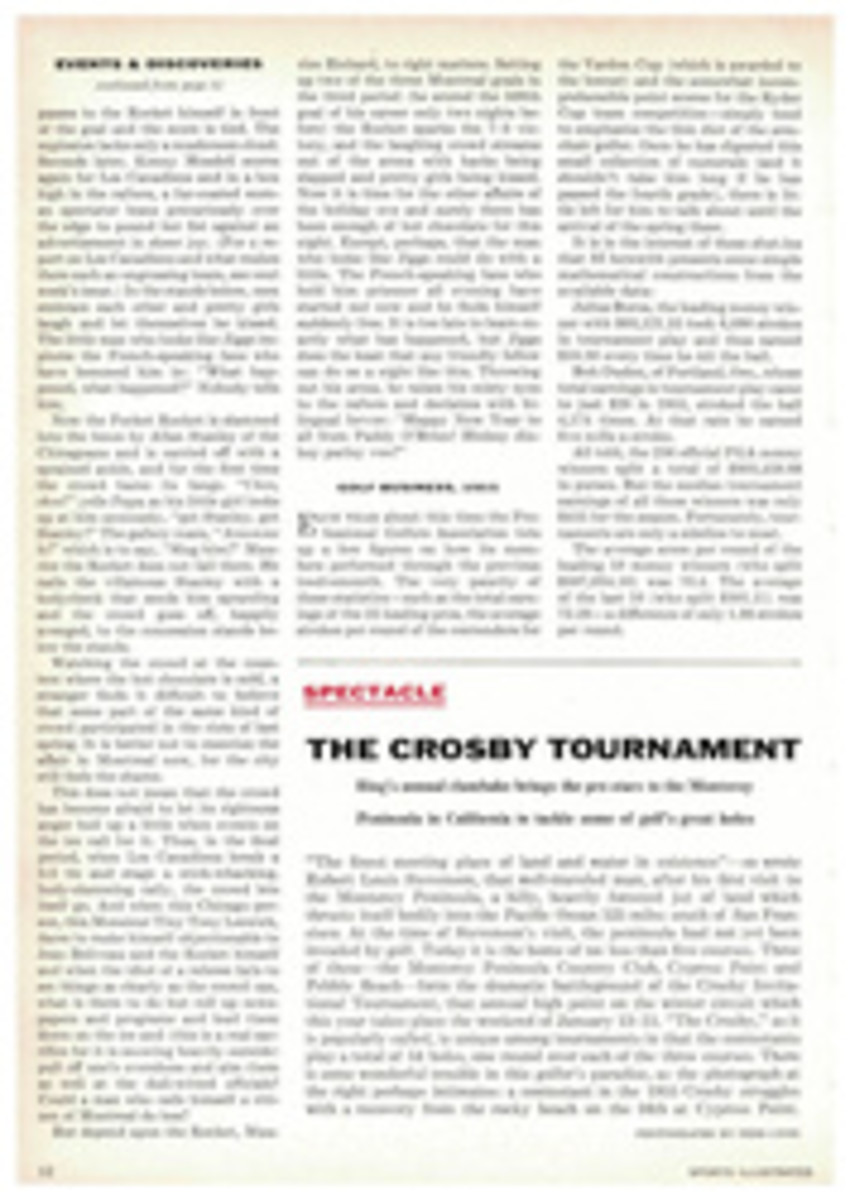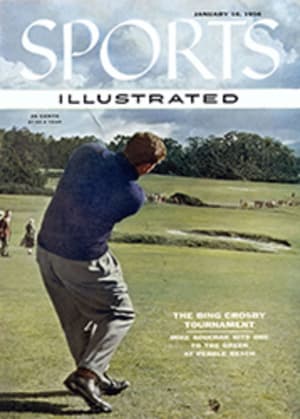
BRING ON THE HAY BALES
A flash of redcatches the eye before the hum of a powerful engine reaches the ear. Far down astraightaway on General Motors' vast proving ground near Detroit a sports carstreaks onward in the pale afternoon sunlight. The hum becomes a roar as thesteel guts of the car yield more speed: 115...120...125. Going flat out as itpasses, the car is a red blur against the snow-carpeted earth, and the speedsoars to 133 mph....
Fifty milesnorthwest of Detroit a network of test roads scars the pine-studded hills anddales of General Motors' 3,000-acre proving ground. Snow was on the ground oneday last week, but the neatly scraped roads were abuzz with the usual scores ofcars under test. Not so usual was the car we had come to see and drive. It wasa sports car, and that is a term which was only recently added to Detroit'slexicon.
New as the newyear, the car was Chevrolet's jaunty 1956 Corvette, which was announced to thepublic this week and which will make its public bow at the GM Motorama nextweek in Manhattan's Waldorf-Astoria Hotel. As the little two-seater whippednimbly through a series of acceleration tests and high-speed runs, it becameapparent that this is a significant car.
The significancelies not so much in its brisk acceleration and a top speed of more than 130 mphas in the fact that Detroit, in the throes of the industry's hottest productionand sales war ever, is aggressively broadening its commitment to sports cars.The giants of Detroit have slumbered while smaller European manufacturers havemonopolized the laurels of sports car racing. Like the Ford Thunderbird, thehot new Corvette is a signal that the giants are stirring.
The significantfigure behind the Corvette is GM President Harlow Curtice himself. Curtice'sphilosophy of competition was illuminated earlier in his career when thequestion involved GM's then-floundering Allison aircraft subsidiary. GM could"continue as is," he was advised, or get out of the aircraft enginebusiness entirely, or make the moves necessary to leadership. Curtice's dictum:he would "only be satisfied with leadership." It was in the same spiritthat Harlow Curtice ordered his engineers to overtake Ford's Thunderbird (SI,Dec. 12). The immediate result is the 1956 Corvette featuring a restyledfiber-glass body, a powerful V-8 engine with horsepower boosted from 195 to225, a choice for the first time between automatic transmission and themanually operated gearshift which the racing enthusiast needs and demands.
That America isseeing a Corvette-Thunderbird tussle at all is a tribute to the postwar sportscar boom to which Detroit was so long indifferent. When the first small,lively, highly maneuverable European cars began to arrive, many an Americandiscovered a way of motoring that Detroit did not provide. It was a discoverycoupled with a sense of fun and adventure—in a way a return to earlier timeswhen the art of driving was a challenge and a pleasure. Chevrolet made thefirst move with its 1953 Corvette, only to watch Ford come along in 1954 with amore powerful car, with more passenger car comforts. Moreover, Ford discoveredthat even with nonbuyers the Thunderbird look was astonishingly popular. Itbrought people into the showrooms, and it made possible one of the shrewdeststandard car sales promotions in recent years ("Kissin' cousin to aThunderbird").
Except for briefand unhappy ventures like the fiber-glass Kaiser Darrin and Nash'sItalian-English-American Nash-Healey, the rest of the industry declined to jointhe chase. It did, however, reflect the sports car influence to the extent ofbuilding sporting-type cars—higher performance machines, usually with the samewheelbase as standard models. Examples are the new Studebaker Golden Hawk andcars in each of the Chrysler Corporation's production lines: the Plymouth Fury,the Dodge 500, the DeSoto Adventurer and the Chrysler 300B. With 340horsepower, the 300B has the most powerful production engine in the U.S.
TOURING NOW,RACING LATER
Sports cars areusually classified either as all-out racing, touring or dual-purpose cars.Chevrolet's new Corvette demonstrated last week that it was a highly suitablesports-touring car with at least modest usefulness right now as a racingmachine and with bright promise for the future.
The Corvette isso new that the only car available for test last week was a factory modelcomplete with the new chassis and engine but fitted with a 1955 body shell.Bodies old and new weigh almost the same (of racing significance is the plasticbody's lightness).
The hot newengine has been given its 30-horsepower boost over the old (the six-cylinderunit has been discontinued) by the use of two four-throat carburetors ratherthan one, a compression ratio increased from 8 to one to 9.25 to one andmodified manifolds to facilitate engine breathing. At idling speed the engineruns smoothly, without the gasp and burble frequently present with multiplecarburetors, and on the road the smoothness of the short-stroke engine isoutstanding.
With a spin ofthe wheels and a chirp from the tires the car surged ahead from a standingstart in the main acceleration runs, and in these exhibited an eagerness thatwould be appreciated in any sports car league: zero to 60 mph in 7.5 secondsand zero to 100 in 19.4, for example.
A primary reasonfor the excellence of these figures lies in the manually operated three-speedgearbox. Impossible to obtain with the optional automatic transmission, thespeeds name without protest with the use of the hand shift. It is too bad thatCorvette could not have come up with the kind of four-speed box generally foundin European sports cars. As it was, the low gear was a little too low to do thework of second on a four-speed gearbox, second too low for the work of third,and the ideal ratio for the hard pull from a dead stop was forgone entirely.But since any touring model necessarily includes compromises and the cost of anew four-speed box for the Corvette alone would be very high, this point is onefor future remedy.
The brakes wereeffective for two consecutive emergency stops from 100 mph, which is sufficientfor touring purposes. But it is axiomatic that touring car brakes areinadequate to the demands of racing and lead to sharp disputes with the haybales that mark fast-looming corners. Possibly Chevrolet will make available,as other manufacturers have, a racing brake kit providing better cooling,larger drums, or another of several solutions.
Handlingqualities of the car were good. It will not take an experienced road racer totravel swiftly and surely in the Corvette; with its tidy 102-inch wheelbase andchassis improvements, the car responded quickly and recovered naturally.
In the top speedruns, made over a pair of especially opened 2.5-mile straightaways, theCorvette traveled north in a mild three-mph wind from south southeast to reachthe best figure—133 mph. Southward the car hit 130 mph for an excellent averageabove the 130-mph mark. An optional rear axle ratio of 3.27 to one will beavailable, incidentally, and with it the enthusiastic driver will be able toachieve an even better top speed than with the standard 3.55 to one ratio.
The new Corvettebody shows a few changes from the old. Gone are the jutting taillights andrecessed, mesh-covered headlights. The headlights now project forward slightly.Formerly unbroken, the side contour of the car now contains a sculptureddepression, outlined with chrome. A push button controls the raising of theconvertible plastic top, and a plastic hardtop that fastens easily and quicklyis available at extra cost. Side windows have replaced side screens; thecrank-up kind are standard, with power-operated windows optional.
Though the weightof 2,930 pounds with optional radio, heater, power windows and five gallons ofgas is not light for a racing sports car, it is a significantly low figure in atouring-sports car of this large displacement. It implies good performances inseveral departments which are difficult to measure but highly important: brakeloading is relieved, tire wear diminished, cornering improved and fuelconsumption reduced. All these factors, incidentally, become vital when the caris raced.
So that is thenew Corvette, in performance and packaging. If SI's experts are correct indefining a sports car as a lawful road car in which varying degrees ofconvenience, accommodation and economy are sacrificed for a performancedemonstrably superior to other current cars of similar displacement, then theCorvette qualifies with resounding impact.
No productionschedule for the St. Louis assembly plant has been announced, but the car willbe available in small quantities at the end of the month. How soon the averageshowroom shopper might be able to drive one away is conjecture—possibly notuntil spring. Chevrolet officials said a price scale has not yet been workedout. For 1955 a middle-range price was $3,250. In 1956 the scale will behigher, but by how much remains to be seen.
As the Corvettesappear, speculation on the scrap with Thunderbird will intensify. So far mostof the rounds have gone to the Thunderbird. Sales for the first year exceeded16,000, current production is 65 cars a day, and there is a backlog of 2,500orders. More than 4,000 Corvettes had been sold by last spring, but currenttotal sales figures are not obtainable.
Introduced inNovember, the 1956 Thunderbird has generally the same persuasive styling and,with boosted horsepower and a choice of three power plants, will be no easybird to catch in the sales tussle.
The Corvetteitself will be hard to catch on a racing circuit in a match with theThunderbird, and that kind of race will be worth going to some trouble to see.But beyond that, a Detroit decision to be satisfied "only withleadership," in the Harlow Curtice phrase, will inevitably lead the U.S.down the rough and hazardous road toward the racing championships of the world.If this happens there will be several passengers who will not enjoy the ride.Some stockholders will become shrilly audible and a few policy makers will beviolently racing car sick.
But there is onlyone road to leadership in sports cars. It is lined with hay bales.
[This articlecontains a table. Please see hardcopy of magazine or PDF.]
PHOTO
FORD THUNDERBIRD (1956 model shown here) has been U.S. leader in its field since 1954, and is the car General Motors has set out to overtake with '56 Corvette.
PHOTO
A TEST MODEL OF THE CHEVROLET CORVETTE, SHOWING 1956'S REDESIGNED FIBER-GLASS BODY, BARRELS DOWN A GENERAL MOTORS SPEED STRIP IN MICHIGAN. NEW CAR BOASTS 225 HP
PHOTO
ENGINEER Zora Duntov, who is responsible for some of Corvette's mechanical advances, discusses them with John Fitch.
PHOTO

